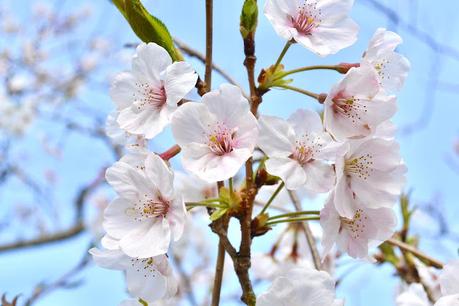Flowers are beautiful . .. .. they pervade fragrance and happiness. Imagine walking in a beautiful garden - sweet scent would waft through the air. In a Temple they pervade divinity. The blooming and fragrance is perhaps part of a strategy that helps flowering plants reproduce themselves and spread their species. Plants flower to produce seeds that can go on to become new plants. To make a viable seed, pollen from one part of the flower must fertilize the ovules in another part of the flower. Some plants can self-pollinate, using their own pollen to fertilize the ovule. Others require pollen from another plant of the same species – that’s called cross-pollination.

Hanami ("flower viewing") is the Japanese traditional custom of enjoying the transient beauty of flowers; flowers (hana) in this case almost always refer to those of the cherry (sakura) or, less frequently, plum (ume) trees. From the end of March to early May, cherry trees bloom all over Japan, and around the first of February on the island of Okinawa.The blossom forecast (sakura-zensen) "cherry blossom front" is announced each year by the Japan Meteorological Agency, and is watched carefully by those planning hanami as the blossoms only last a week or two.In modern-day Japan, hanami mostly consists of having an outdoor party beneath the sakura during daytime or at night. A more ancient form of hanami also exists in Japan, which is enjoying the plum blossoms, instead, which is narrowly referred to as umemi (plum-viewing). This kind of hanami is popular among older people, because they are calmer than the sakura parties, which usually involve younger people and can sometimes be very crowded and noisy.
A cherry blossom is a flower of many trees of genus Prunus or Prunus subg. Cerasus. They are known as Japanese cherry and sakura and refer to ornamental cherry trees, not to be confused with cherry trees that produce fruit for eating. They are considered the national flower of Japan.[6]
Wild species of cherry tree are widely distributed mainly in the Northern hemisphere. In the mainstream classification in Europe and North America, cherry trees for ornamental purposes are classified into the genus Prunus which consists of about 400 species. In the mainstream classification in Japan, China, and Russia, on the other hand, ornamental cherry trees are classified into the genus Cerasus, which consists of about 100 species separated from the genus Prunus, and the genus Cerasus does not include Prunus salicina, Prunus persica (Peach), Prunus mume, Prunus grayana, amongst others. Due to its diverse presence, it is considered that the culture of viewing cherry blossoms and the production of cultivars have developed historically in Japan. Many of the cherry trees currently enjoyed for cherry blossom viewing are not wild species but cultivar. Because cherry trees have a mutable trait, many cultivars have been created for cherry blossom viewing, especially in Japan.
After two years of pandemic-related cancellations and restrictions, Japan is again observing the time-honoured ritual of hanami – cherry blossom viewing.As the delicate pink flowers reached their peak, people who had previously avoided the crowds – or had their local viewing festivals called off – have turned out in large numbers to view Tokyo’s sakura petals.But a rise in Covid-19 cases in the capital since quasi-emergency restrictions were lifted at the start of last week has sparked concern that the long-awaited hanami season could help fuel a resurgence.
At Chidorigafuchi park, a famous hanami spot northwest of the imperial palace, thousands of people viewed the flowers as they walked beneath rows of trees or from rowing boats on the palace moat. The blossoms reached full bloom in Tokyo on Sunday – four days earlier than average but five days later than last year – when temperatures reached 21C, according to the meteorological agency.“ I feel like life has finally gotten back to normal,” Takanori Shiwaku, a 62-year-old cafe owner, said as he strolled in the park. “Here in the downtown area, people have waited for this for so long.” Midori Hayashi, 75, has spent most of the past two years staying at home. Hayashi said she was “really happy” to finally be able to admire the blossoms.
While Covid-19 measures, including restrictions on bar and restaurant opening times, were lifted on 21 March, local authorities have asked hanami-goers to be vigilant.Shigeru Omi, who heads the government’s coronavirus advisory panel, urged them to wear masks and avoid parties where large numbers of people eat and drink together, the Japan Times said.Tokyo reported 7,846 new Covid-19 cases on Tuesday, more than twice the 3,533 a week earlier, in a resurgence attributed to the BA.2 subvariant of Omicron !!.
Cherry blossom might have rung a different bell .. .. when you buy a new pair of shoes, you want to make sure that they last and look like-new for years to come. Maintenance of footwear is an often-neglected practice but it always pays dividends. From something as simple as cleaning your footwear once a week, to cleaning, polishing, protecting and even replacing the insoles and accessories on your footwear – preserving is an easy act to follow. If your shoes are a little tight after purchase, don't force them on as this can cause damage to their backs and that won't be easy to reverse. Use a simple Shoe Horn, which provides a smooth ramp that allows your feet to easily move into your shoes without risking damage.

Cherry Blossom is another name just a Kiwi boot polish that strikes mind immediately when we think of shoes and polish. Cherry blossom is produced in Derbyshire, England. Its website reads that the brand's aim is a simple one – to keep your feet moving, and make you feel and look your best, by preparing all footwear for the chaos of an unpredictable world.
Slightly more than a century ago, in 1906, tired of having shoe polish rub off onto their clothing, Dan and Charles Mason decide to create a polish that would last an entire day. They called the product Cherry Blossom Boot Polish and launched it across the UK. After its success, in 1913, the Chiswick Polish Company, owned jointly by the Masons and Reckitt & Sons Ltd, was founded. Its website adds that - with workers’ welfare high on the agenda at Cherry Blossom, a staff magazine called “Forward” was launched in 1916. Shortly after, the company introduced a 5-day working week in 1918 and a pension scheme in 1923.
Interesting !
With regards – S. Sampathkumar31st Mar 2022.

